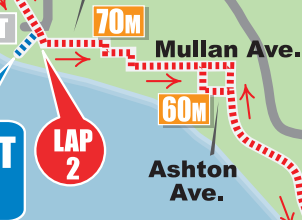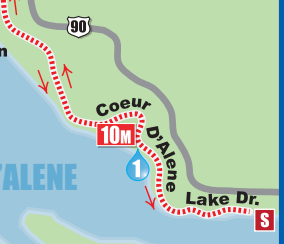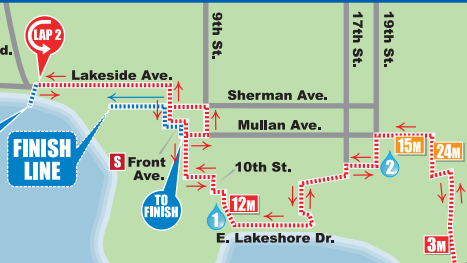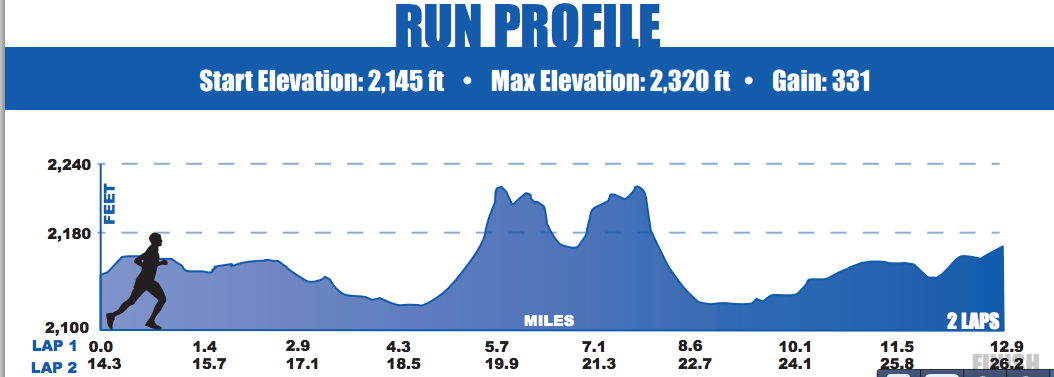Endurance Nation has a long history on the Ironman® Coeur d’Alene course: Coach Rich raced the event in ’03, ’05, and ’08, with a PR of 10:02, has been on hand for the race pretty much every year, and has coached hundreds to the Coeur d’Alene finish line. Coach Patrick raced Coeur d’Alene in ’08, finishing in 10:04. Finally TeamEN has had 18 to 35 athletes at the race every years since 2008.
We’d like to share that experience with you with these consolidated tips and resources specific to the Coeur d’Alene course:
Weather
In our opinion, Coeur d’Alene has seen some of the most variable of any US Ironman® course — frigid waters for the swim, cold, overcast, rain, heat and wind on the bike, and temps in the 90’s on the run. In short, you need to be prepared, and adapted, to race in any conditions.
That said, don’t sweat the weather report until about Friday of race week. Again, we’ve seen the weather change dramatically in the last fews days before the race and the forecast for Sunday won’t be accurate until Saturday morning. Likewise, the lake temperature changes very quickly so don’t think too much about it until, again, about Friday of race week. In 2008 the water was about 54°F for our practice swim on Wednesday (VERY cold!) but had warmed up a bit to 58°F or 59°F by Sunday.
Timing of the Event
The timing of an event should the #1 criteria you use for selecting what Ironman® to train for and race — not hills, not weather, not water temperature, but does rather the timing of the event work for you.
Will you have cooperative weather and hours of daylight available for training, especially in the last 8-10wks of your work up?
Do not underestimate the challenges of long, long rides on the trainer necessitated by choosing a sub-optimal combination of race date and your typical weather conditions in your final workup.
So the combination of the variable weather and the June date of the race means that you need to have time to acclimate to the heat, in the event CDA serves up a hot day. And hours of daylight and getting in the bike miles are a concern beginning around early April, when your training begins to ramp up. Below are our notes on how all of this shakes out for US-based athletes:
- Southeast: timing of the race is good, with regards to hours of daylight, the ability to train outside, and to acclimatize to the potential heat of the race.
- Northeast: timing is…fair to meh and is highly dependent on how winter goes for you — still on a trainer in early to mid April? Ugg, not the best. Regardless, you will likely not have an opportunity to acclimatize to heat.
- Midwest: not good, as a function of ability to get outside and acclimatize.
- Northwest: training outside = fair; acclimatize = not so good; logistics and travel costs = a no-brainer.
- Southwest and West: no issues with hours of daylight, weather, and the ability to train outdoors. Heat acclimatization is a toss-up, as a function of where you live: AZ is different from SoCal is different from NoCal, but Coeur d’Alene is generally very popular with Southwest and West athletes.
The Venue
Travel costs and logistics: CDA is about a 35 minute drive from Spokane, WA, so lots of flights are available.
Lodging: ALL hotels in the area are booked (HoopsFest + Coeur d’Alene) and rates are jacked up a bit (or a lot) in CDA. Rich has often been able to book a more affordable hotel in Spokane and drive 30′ each way to the race.
Parking: rather than drive around and around trying to find a spot on the street, just park at the large resort / city lot downtown. The parking rates are very affordable relative to big city rates.
Dining: lots of options to suit just about anyone. Be sure to visit Java on Sherman for the Mexican chocolate mocha!
Now, let’s get on with the race!
The Swim
Practice Swims: the course won’t be setup until Saturday afternoon. You’ll be able to swim in the lake before race day but not straight out along where the swim course will be — Coeur d’Alene has a lot of boating traffic so best to swim parallel to the shore. We recommend you enter the water and swim out from shore about 200-300m, picking up landmarks for navigation on the opposite shore. Then bang a right, swim, flip it and come back. It’s more important that you get a feel for the water temp conditions.
The Swim Start: from 2003 to 2011, the Coeur d’Alene swim start had gained a reputation for being one of the roughest in the sport. With nearly 3000 athletes all jammed into a narrow beach with an 800m swim to the first turn, there was a LOT of contact. However, WTC announced a new swim start protocol for the 2013 race, which produced a much safer and tamer Coeur d’Alene swim experience.
The Course: the Coeur d’Alene swim is a two loop affair in a lake, from a beach start. You’ll swim directly out from shore about 800m, turn left and swim about 150m, turn left again and swim back to shore. Exit the water, run over a timing mat, run/swim diagonally out to the first buoy, repeat.
The Temps: the water temperature has been very cold, from the high 50’s to the very low 60’s for a number of years. We recommend bringing a full wetsuit (duh!!) and a neoprene cap. Some athletes opt to wear booties, if the race allows them.
The Transition
Coeur d’Alene has one of the nicest and fastest transitions in the sport. No crazy long run from the lake, up a street and into a skating rink (IMLP), no ludicrous long run up a parking garage helix and then to your bike (IMWI). Nope! Instead, your bags are outside on tennis courts, your bike is racked on shaded grass, and everything is only a few yards from the swim finish!
The Bike
Go here for the full course map.
Introduced in 2012, this is the 3rd permutation of the Coeur d’Alene bike course. This is our breakdown of the course, how to ride it and what mistakes to avoid, as a description of one lap of the course:
 Miles 0-3, and about 13-16: Admin through Town
Miles 0-3, and about 13-16: Admin through Town
admin, with lots of turns and traffic getting you out to the lake and the out and back. IGNORE the crit-style racing of others, be safe and just get out to the lake.
Same drill when you come back into town at the end of the lake out and back, but you’ll be going fast down a gradual downhill with a LOT of spectators on the side who may not be looking at you. Keep your head on a swivel and look out for an inattentive spectator crossing in front of you.

Miles 4-13: Lake Out and Back
If you reference the bike course profile here, you’ll see there are a couple rollers here really nothing of note. That said, athletes who are caught up in the excitement of the race tend to drill it up the hill at about mile 6 — the same hill you’ll be climbing on the run at the far end of the late.
Just sit down, relax, ride easy and ignore the hammerheads around you. In our opinion, this about 20 mile section (admin + lake out and back + out to the first climb), which you’ll do two times = about 40 miles, are essentially free, in that there’s really nothing to be concerned or worried about. Just ride steady, ride your race, and ignore the other athletes around you.
Finally, note that Bike Special Needs will be in the culdesac/turn around at the far end of the lake. This is about mile 64 or 65, NOT mile 56, so plan accordingly.
Miles 19 to about 35: The Plateau
After about 16 “free” miles you’ll turn south on Hwy 95 for about 2 more flat miles before hitting your first true climb of the day. After a short and fast descent note that climb less steeply up into a plateau, into another hill, down, another hill, flip it and come back.
Our notes for this section:
- This is a major four lane highway, with the associated grades — nothing here is steeper than 6% — and the pavement surface is excellent.
- Before you freak out about the steepness of the first climb, note the elevation scale and change on the left axis. We can tell you this hill is 1.8 miles at a constant 6% grade. In other words, it’s not crazy, it’s not steep, it’s nothing that you haven’t probably seen countless times before.
- Most importantly, the first hill and subsequent hills are very easy to figure out: you’ll see them coming from a long way away; they are not particularly steep, and they are long enough that only the most undisciplined riders will try to hammer up them. And that error will certainly be self-correcting by the 2nd time around!
- Because you are going in one direction for a long time, winds are the primary concern: if you are riding a little or a lot too hard or two easy into a headwind or with a tailwind, that mistake while have about 15 miles to express itself. That said, the weather changes a lot at CDA so there really is no predicting from where the winds will be on race day. Just pay attention to your effort and ignore the winds:
- We don’t ride harder or increase our effort into a headwind, and…
- We don’t come off the gas or ride easier with a tailwind.
- Finally, in 2012 the race mandated a no passing zone on the downhill that begins at about mile 46 and on the bridge at the bottom of this hill. Again, read the Athletes’ Guide for more details.
The Run
The complete run course map is here
2012 was the second version of the run course and remains the same for this year. The race eliminated the flat, shaded, 2 mile out and back along the lake out of transition and extended the course into the hills on the far end of the lake.
Miles 0-3, 10-15, 23-26:
- Lots of spectator mojo in the first two miles and many, many athletes run much too fast here. Don’t be one of them!
- This section is basically flat, with a couple very short downhills.
- Many turns that can get annoying as the race brings you out to the lake, where the majority of the course is.
- You’ll run through this section again at end of the first and start of the second laps, or miles 10-15. Enjoy the crowd support and the mojo as you cross Sherman (look to your left to see your finish line!) and Lakeside, then settle in for the run along the lake.
The Lake Out and Back:
It’s best to talk about this section by looking at the run elevation profile below.
Note that you’ll turn right and be sorta-next to the lake at about mile 2.8. From this point,
- The profile makes it appear the run is downhill to mile 4.3, but it is, but note the scale: it’s a very small elevation change and basically flat.
- At the far end of the lake you’ll climb about a mile at about 3-4%, down a bit, then up, then a bigger down, then flip it and come back.
- That 3-4% climb is now a downhill, into flat along the lake, then a bit of a long up (not steep it at all, it’s just…there), when you turn left and head back into the residential area, with lots of turns, back to the race start.
- Flat along the lake: very exposed, with little shade. However, you have some choice of running surface, between asphalt bike path, grass, and dirt.
- The hills at the far end: not too bad on the first lap but on the second lap they’ll hit you right when the run begins to get very tough. Maintain yourself across the flat along the lake, conserving your energy for a good effort up the hills on the far end. Carry that downhill momentum until the flat.
- Just put your head down in the last 3-4 miles. The many turns in this section make it very difficult to maintain a sense of where you are relative to the finish line.
Finish Line
Awesome! You’ll bang a left on Sherman, a four lane street blocked off for the race, and see the finish ahead. And don’t be surprised at what appears to be longest less-than-a-mile you’ve ever seen! You’ll have the first couple blocks to yourself and then the crowd and noise grows and grows. Enjoy and don’t forget to ham it up in the chute!
TeamEN Race Reports and Podcasts:
We’ve found race reports to be extremely effective tools to teach our athletes how to race: TeamEN post their race reports, as well as their race and race rehearsal plans, in our forums for peer review from their comrades. The result is a very rich, team-wide knowledge base of race execution tips and a culture of athletes helping athletes learn now to race better.
Endurance Nation Blog: Ironman® Coeur d’Alene Race Report Archive
Endurance Nation Podcast Channel: Ironman® Coeur d’Alene Race Report Podcast Interviews
Racing Ironman? Attend Our FREE, LIVE Four Keys Talks!
Learn how to execute like a pro with our free Triathlon Execution Seminar
IRONMAN® is a registered trademark of World Triathlon Corporation, is not affiliated with Endurance Nation®, and does not endorse or sponsor our products, materials or events.





Timothy
Though most have already made hotel arrangements for CdA and Spokane, you are in luck in the fact that Hoopfest is actually taking place a week later this year. So hopefully finding a place to stay will be much easier. I sure hope this is the case next year, since IMCdA is a week later for 2014, and occurring on June 29th.